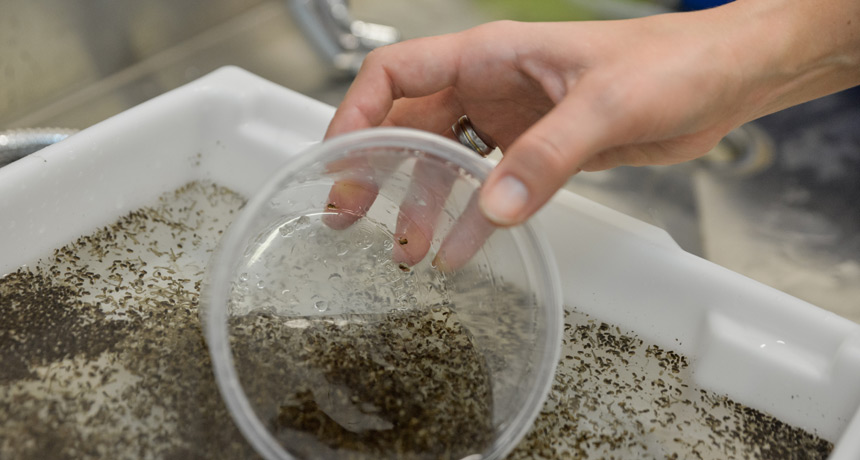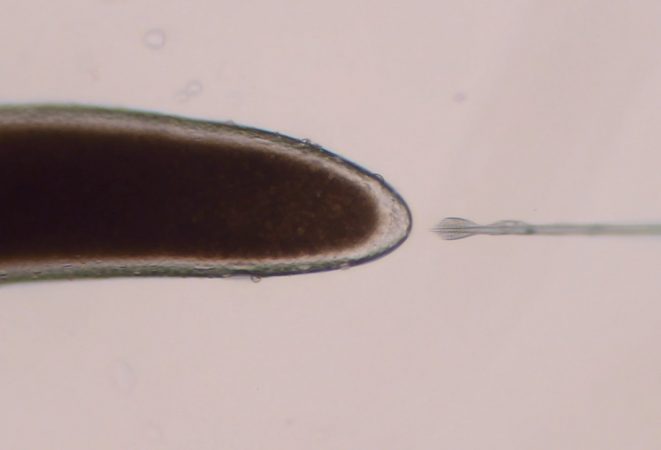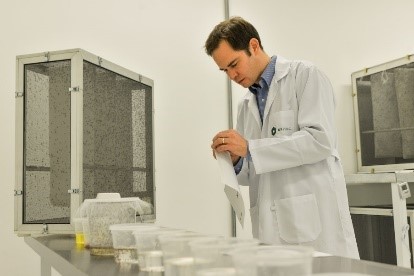GM mosquitoes cut rate of viral disease in Brazil
The genetically modified insects were unable to produce blood-sucking young

Immature GM mosquitoes being raised in the lab. Adults from such breeding programs were released into the wild. They helped cut the rate of dengue fever in one Brazilian community.
Oxitec
By Susan Milius
Tweaking the genes of mosquitoes that can carry disease can transform those blood suckers into weapons that fight disease. This is the finding of a new study in Brazil.
Dengue (DEN-gay) fever is a viral disease spread by Aedes aegypti mosquitoes. This potentially life-threatening infectious disease causes high fevers, headaches, pain and sometimes mild to severe bleeding. Because there is no cure, health officials are always on the lookout for ways to slow the spread of this virus. And one new approach is to slow the growth of mosquito populations.
By altering the genes in male mosquitoes, researchers have just impaired the ability of these insects to reproduce. Then they released the guys throughout several neighborhoods in the city of Piracicaba. And over the next year, the presence of those altered males put a dent in the town’s number of new dengue cases.
Health officials used regular methods to limiting new skeeter-breeding grounds throughout much of the city. Such measures included keeping stagnant water from collecting outside of homes in buckets, plant saucers or other spots.

Where such control measures were taken, the number of new dengue cases dropped by 52 percent over a year, beginning in mid-2015. But in neighborhoods where the altered males were released as an extra control, the results were much, much better. Dengue cases there dropped 91 percent — from 133 to a mere 12.
Oxitec is the biotechnology company based in Abingdon, England, that created the altered male insects. On July 14 it reported that its new data linked the release of those those altered male insects with a sharp drop in disease.
It works by romantic deception
The gene changes in the male mosquitoes was small — but important. The guys can still mate. Their mates will still lay eggs that hatch and grow. But these young are not healthy. Their DNA has a built-in self-destruct switch. As a result, the young die off in the wild before they are mature enough to bite.
This is a modern biotech twist on a decades-old insect control technique. It relies on releasing sterile males, ones that cannot fertilize a females’ eggs. (If enough sterile guys are flying around in the wild, the females will waste their reproductive effort. Eventually, the population breeds itself out of existence.)
In earlier tests in other parts of the world, Oxitec showed that mosquito numbers will fall when the genetically altered males swarm through a neighborhood. But the company’s new report is the first claim that when mosquito numbers fall, so do the cases of disease.

That information — though preliminary — could help to fill a data gap that has provoked a debate in the Florida Keys over a proposed release of such mosquitoes there. Many people oppose releasing genetically modified, or GM, organisms into the wild. The company says that almost all the releases will be males that will die and leave no adult offspring. (The adults bite animals, which can spread disease.)
Brazil, however, has suffered for years from dengue — and now the Zika virus. Conditions in some areas have been so dire that officials in that land are much more welcoming of tests with GM mosquitoes.
In the recent trial, Oxitec looked at the numbers of dengue cases reported mid-year to mid-year from Piracicaba’s dengue surveillance program. The GM mosquito test focused on just one area in the city. Called CECAP/Eldorado, some 5,000 people live here, where the city’s dengue rates were highest in 2014 to 2015. More than five out of every 200 people there became infected. Elsewhere in the city, the rate was less than two out of every 200.
But dengue rates fell dramatically after special mosquito-control measures went into effect, including the release of the GM mosquitoes. Now dengue rates are lower here than throughout the rest of the city — roughly half of the citywide rate.
Data on mosquito populations and diseases are rare and important, says Grayson Brown. He directs a lab on insects and public health at the University of Kentucky in Lexington. He wonders how far down the GM mosquitoes drove the wild mosquito population before dengue rates began to fall. (Oxitec reports that mosquito numbers dropped by 82 percent. But Brown asks: 82 percent of what?)
Plenty of programs monitor disease outbreaks as they treat mosquitoes, Brown notes. Still, it’s hard to justify choosing to leave some parts of a city untreated as part of a test, he adds. And that makes it hard to see how much a treatment has helped. Here that could be tried by adding the extra measure of the GM treatments.







